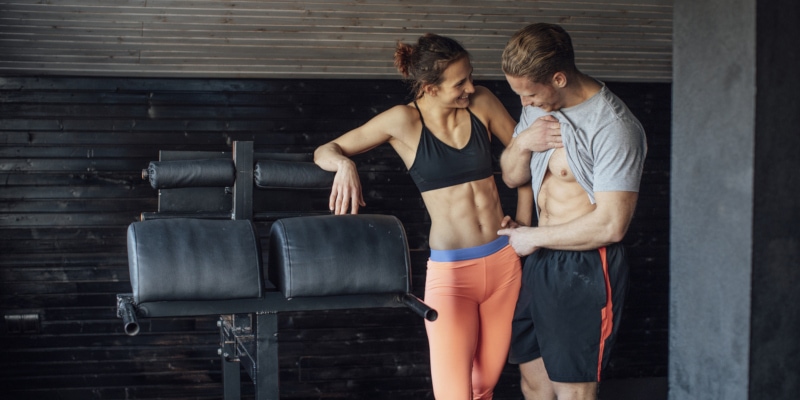Men and women alike are always interested in – among other things – improving the appearance of both their abdominal muscles and their arms. I’m sure many reading this have chosen to do so because the title piqued your interest. If you’ve been reading my blogs about training for any length of time, you may have also asked the question, “When does this guy work the abs and arms?” I’m going to discuss when I don’t, why I don’t, when I do, and why I do.

I don’t recommend any arm work for novice lifters. They just don’t need it. The novice lifter is often very weak. They are in such need of simply getting stronger first before it’s advisable to begin working on aesthetics. The primary lifts they are going to do every single time they train are already going to adequately stress their arm muscles. Not only is it not necessary to do any specific isolation movements for these body parts, but to do so would also compromise their ability to make consistent strength gains in the main lifts. The novice lifter is not yet capable of recovering from the additional isolation work done specifically for the arms. The main lifts that work the arm muscles – namely the biceps and triceps – are the bench press, the press, the bent row, and we can add the chin-up to the list for good measure. These are all compound movements, meaning they use more than one joint or set of joints to perform them. The press and the bench press both place a tremendous amount of work on the triceps. This occurs in conjunction to the deltoids and pectoral muscles also being used to a great extent in the execution of the lifts. The bent row and chin-up are primarily “back” or “lat” exercises, but also place a tremendous amount of stress on the biceps while they are being performed. Simply getting consistently stronger in these primary exercises is adequate to initiate muscle growth in all the desired parts of the anatomy, including the muscles of the arms.

So when do we add arm work? Some lifters never really seem to need to add arm isolation exercises to their program in order to keep making progress in the main lifts. I do find many lifters, though, once they enter into an advanced intermediate level of progress (read the blog “Strength Standards” to learn if you are a novice, intermediate or advanced lifter), do benefit from some specific arm training – particularly for the triceps, which happen to make up over 60% of the mass of the upper arms. The triceps are so integral for the pressing movements that, at more advanced levels of training, relatively weak triceps are the culprit if strength in the press or the bench press fails to keep improving. Aside from that, I’m fine if someone wants to start adding arm work in once they have at least made considerable progress as a novice. I understand that most men want to have muscular arms. I have no problem with that. I just contend that I do not want to waste precious training time doing comparatively lightweight arm isolation exercises before we’ve first gotten to first base with our overall strength. Think of the main exercises of your strength training program as the main course and the arm work as dessert. Did we not learn from Pink Floyd that you can’t have any pudding if you don’t eat your meat? We did, didn’t we? And the forearms get adequate development from the heavy pulling exercises, which tax the grip.
So then what about abs?? Personally, I seldom do any ab exercises. I do on occasion, but I’ve personally gone years without doing any. When I have included ab work, it has proven that I already have strong abs and therefore I don’t find it necessary to include it regularly in my training. Well how are my abs getting strong if I’m not doing abdominal exercises? The secret to this is that most all of the exercises I am performing are making my abs strong. Heavy squatting, deadlifting, pressing, and bent rows all place extremely high demands on the abs. You must remember the primary role of the abdominal muscles is to provide midline stabilization. To perform the aforementioned lifts safely and effectively, the abdominal muscles must work extremely hard to maintain rigid, upright posture throughout the movements. No number of sit-ups or crunches can equal what the heavy barbell movements can do for ab development. For those of you who are concerned about the appearance of visible abs, this has everything to do with bodyfat levels. When I weighed 230 lbs., I had strong abs but not very visible definition. When I weighed 180 lbs., my overall strength was very close to what it was as a heavier lifter, but of course, with less body fat, my abs looked better. I did no more ab work at 180 than I did at 230 lbs. If you do prefer ab work, you can incorporate it at virtually any point in your training. I encourage you to choose movements that impose the demands of midline stabilization versus taking you through spinal flexion. I would do L-hangs, GHD sit-ups (with straight legs) or plank variations and skip the crunches and sit ups altogether. Make the ab work challenging without overdoing the volume (2-5 sets).
There you have it– when to do arms and abs and when not to. In the end, let your goals dictate your decisions. Use the advice I’ve provided here as a guide and feel free to experiment to find what works best for your priorities. It’s about the journey. Have fun.


